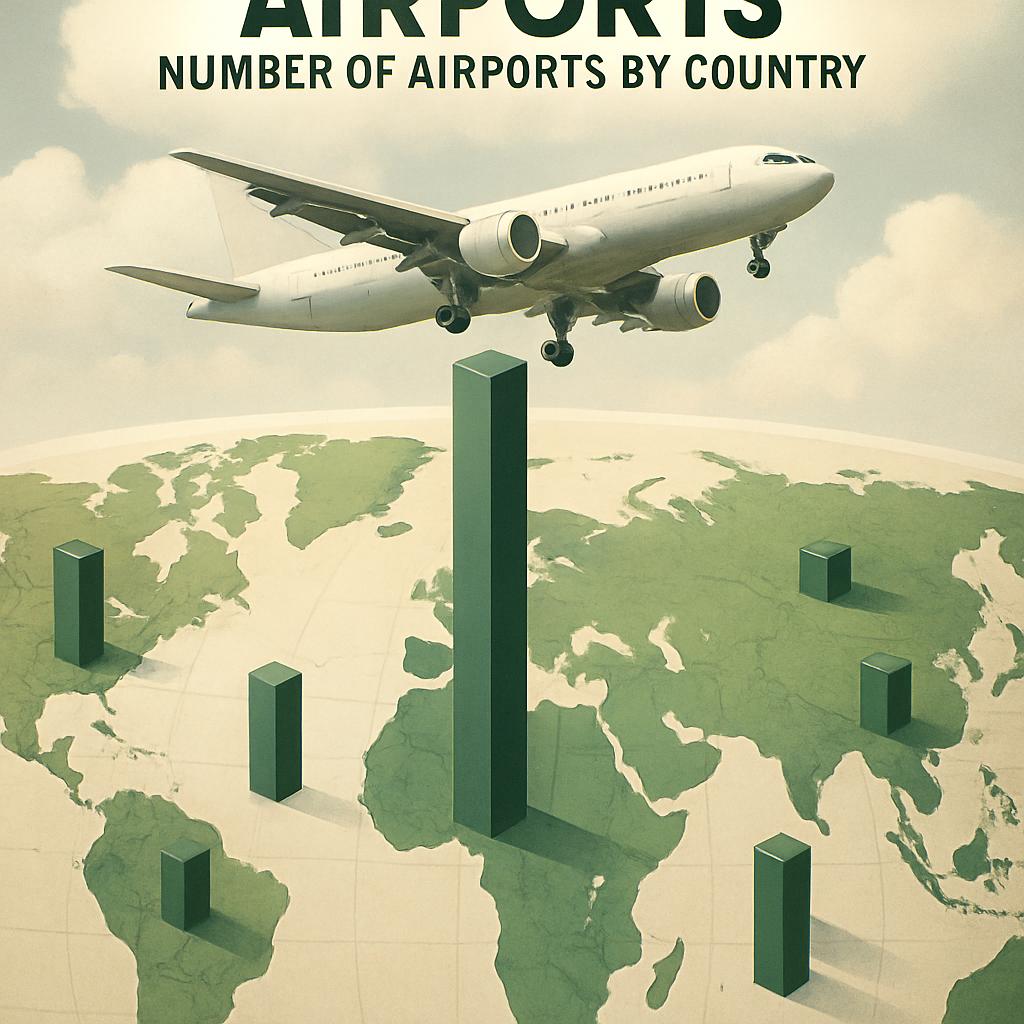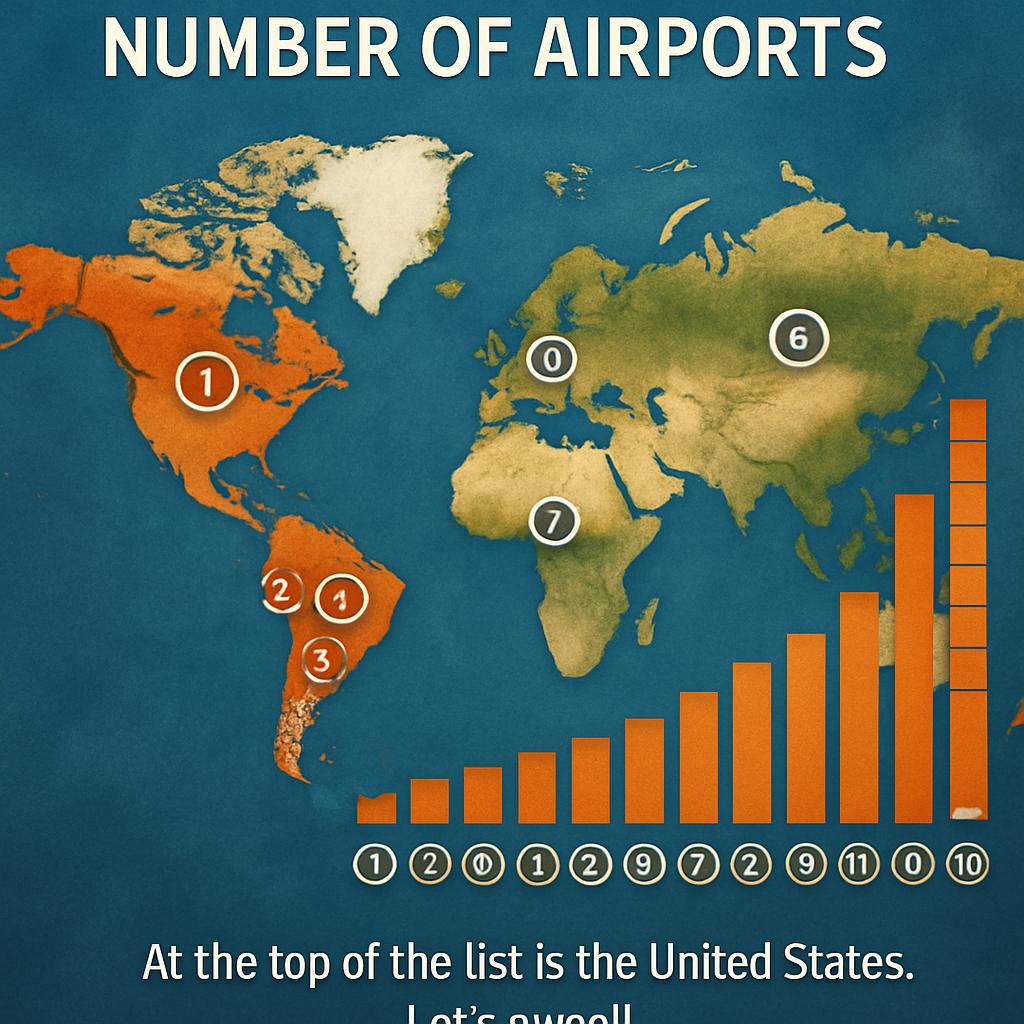Air travel is part infrastructure, part geography, and part culture — and nowhere is that combination clearer than in the map of an individual nation’s airports. This article walks through which countries lead in terms of the number of airports: infographic-style, explaining how different counts are compiled, why some nations have vast networks of airstrips while others concentrate traffic in a handful of hubs, and what those patterns tell us about mobility, economy, and landscape.
- Why count airports at all?
- Defining “airport”: the categories that matter
- Top countries by total number of airports (approximate totals)
- Top countries by number of commercial airports (scheduled passenger service)
- Regional snapshot: North America
- Regional snapshot: South America
- Regional snapshot: Europe
- Regional snapshot: Africa
- Regional snapshot: Asia
- Regional snapshot: Oceania
- Factors that explain why some countries have more airports
- The often-overlooked role of general aviation
- Trends shaping airport numbers today
- Environmental and social implications of large airport networks
- How to read the infographic: visual cues that matter
- Methodology and data caveats
- Practical implications: travelers, businesses, and policymakers
- Stories from the runway: real-life examples
- Case study: why the United States tops the list
- Case study: Brazil’s patchwork of runways
- How technology could reshape airport counts
- What policymakers should weigh when planning airport networks
- Tips for interpreting country rankings in the infographic
- Data transparency: what readers should demand
- Quick list: questions to ask when comparing countries
- Reflections on what airport networks reveal about a country
- Next steps: how to explore the data yourself
- Final thoughts and an invitation
Why count airports at all?
Counting airports is more than an exercise in record-keeping; it’s a window into how people move goods, access services, and connect remote communities. The raw number of airports reflects historical settlement patterns, economic priorities, military needs, and available transport alternatives like roads and railways.
Planners, airlines, investors, and policymakers use airport counts to evaluate connectivity and resilience. For example, a country with many small airstrips may boast superior emergency access for remote regions even if passenger volumes are low at each individual field.
From an infographic perspective, a visual tally of airports invites questions: Are the airports clustered in one region or spread evenly? Do most serve general aviation or scheduled commercial flights? Those distinctions change how you interpret the numbers.
Defining “airport”: the categories that matter
“Airport” can mean many things: a major international terminal, a small paved regional field, an unpaved bush strip, a heliport, or even a seaplane base. Different data sources include different mixes of these categories, so clarity about definitions is essential when comparing countries.
Broad tallies typically include all runways and landing facilities, paved and unpaved, while narrower lists focus only on facilities with scheduled commercial flights. Between those extremes sits general aviation, which often accounts for most of the counted locations in countries with rural populations and private flying cultures.
When we present counts and rankings in this article, we’ll note whether the figures reflect total airfields or commercial airports. That way readers understand why a large, sparsely populated country can appear near the top by total airfields but lower on lists of commercial hubs.
Top countries by total number of airports (approximate totals)
When every runway, grass strip, and seaplane base is counted, a handful of countries stand out because of geography, settlement pattern, and aviation culture. These totals are approximate and drawn from a combination of civil aviation registries and public databases; they’re best understood as orders of magnitude rather than precise daily-updated counts.
The table below lists countries that typically lead in total airport counts, showing rounded estimates to convey scale. Note that figures may vary by source and over time as facilities are opened, upgraded, or formally decommissioned.
| Rank | Country | Approximate number of airports (total) |
|---|---|---|
| 1 | United States | ~13,000+ |
| 2 | Brazil | ~4,000+ |
| 3 | Mexico | ~1,700+ |
| 4 | Canada | ~1,400–1,600 |
| 5 | Australia | ~1,200–1,400 |
| 6 | Russia | ~1,000–1,300 |
| 7 | Argentina | ~900–1,100 |
| 8 | Colombia | ~800–1,000 |
| 9 | Venezuela / Peru | ~700–1,000 (each) |
Those numbers reflect total recorded landing facilities: paved runways, unpaved strips, and many small airfields that serve local communities or private pilots. The United States leads by a wide margin because of its long history of general aviation, dense network of municipal and private airports, and agricultural and business uses of small aircraft.
Brazil’s high count is a product of its size, fragmented riverine and forested territories, and the historical role of aviation in linking remote Amazonian towns. Canada and Australia appear high on these lists for similar reasons — both are large landmasses with low-density populations outside urban centers.
Top countries by number of commercial airports (scheduled passenger service)
Counting only airports that host scheduled commercial passenger flights produces a different ranking, one driven by economic networks and airline route planning rather than private strips. This measure more directly reflects where passengers can reliably travel by air without chartering a plane.
The following table offers approximate counts of airports with scheduled passenger service. These figures are indicative and reflect civil aviation authorities’ data and airline route records rather than total runway inventories.
| Rank | Country | Approximate number of commercial airports |
|---|---|---|
| 1 | United States | ~500+ |
| 2 | China | ~260 |
| 3 | Russia | ~200–250 |
| 4 | India | ~150–160 |
| 5 | Brazil | ~130–150 |
| 6 | Japan | ~90–100 |
| 7 | Germany | ~50–60 |
| 8 | Mexico | ~70 |
| 9 | Turkey | ~80–100 |
| 10 | Spain | ~50–60 |
Note how the commercial list compresses differences. While the United States still leads, the gap between many nations narrows dramatically because scheduled routes are concentrated in economic hubs and viable markets. China’s substantial investment in civil aviation over recent decades is reflected in a fast-growing network of commercial airports.
Smaller European countries may have fewer total fields, but many operate efficient regional airports that support dense domestic and international networks. The takeaway: “number of airports” changes meaning depending on whether you measure total facilities or commercial connectivity.
Regional snapshot: North America
North America, especially the United States and Canada, illustrates the divide between total airports and commercial hubs. The U.S. has an enormous general aviation culture, with thousands of small public and private fields that supported the growth of aviation since the early 20th century.
Canada’s long distances and sparsely populated northern regions have led to the establishment of many small airstrips, floatplane bases, and remote fields that are vital for supply, medevac, and passenger service. Mexico sits between these extremes: a fair number of small fields combined with a robust set of commercial airports supporting tourism and domestic travel.
Regional snapshot: South America
South America’s geography — with the Amazon basin, Andean ranges, and long coastlines — has made aviation essential to connecting isolated communities. Brazil leads the continent in total runway counts because of its vast interior and riverine towns accessible more easily by air than by road.
Countries like Colombia, Peru, and Argentina have many regional fields as well, often used for short-haul links that bypass difficult terrain. In some cases, the density of small airports reflects historical patterns of mining, oil exploration, and regional economies that relied on floatplanes and bush operations.
Regional snapshot: Europe
Europe is dense in commercial connectivity but relatively modest in total airstrip counts compared with continental giants. High road and rail connectivity reduce the need for thousands of small landing strips, but Europe’s many regional airports support frequent scheduled routes and low-cost carriers.
Western European countries tend to concentrate passenger traffic at a handful of well-equipped hubs and several regional airports, while Eastern Europe still retains numerous smaller aerodromes, some of which were built during Cold War military planning and later converted to civil use.
Regional snapshot: Africa
Africa presents a mixed picture: some countries have many airstrips serving remote and rural areas, while others have surprisingly sparse networks due to underinvestment in infrastructure. Large-scale distances, poor road networks, and challenging terrain mean aviation remains vital in several regions.
Tourism-oriented countries such as South Africa and Kenya maintain fairly developed commercial networks, while nations with dispersed populations or conflict zones often rely on humanitarian and charter aviation more than scheduled passenger services. Data quality can be uneven, and some remote fields are functionally informal landing sites not captured in all datasets.
Regional snapshot: Asia
Asia’s diversity shows in airport counts: densely populated, high-income countries like Japan and South Korea have many commercial airports relative to their size, while China’s rapid airport build-out has increased both commercial and regional fields dramatically in recent decades. India is expanding both civil and regional services to improve domestic connectivity.
In Southeast Asia, archipelagic nations such as Indonesia and the Philippines require many inter-island airports to knit together thousands of islands, making their airport totals larger than land area alone might suggest. Overall, Asia’s mix of megacities, islands, and emerging markets drives varied airport development strategies.
Regional snapshot: Oceania
Oceania’s high per-capita airport counts result from vast distances over water and the need to connect remote communities, especially in Australia and the Pacific island states. Australia’s large interior uses light aircraft and regional fields extensively for medical, agricultural, and logistical roles.
Small island nations maintain single or a handful of airports that are lifelines for tourism and supply, which means airport count alone understates their strategic importance. In many Pacific nations, upgrades to a single runway can transform a country’s access to tourism dollars and essential services.
Factors that explain why some countries have more airports
Geography is central: large land area with low population density produces more small airfields for local access. Australia, Canada, and the United States are classic examples where scattered population centers and long distances favor many small fields and airstrips.
Historical drivers shape the pattern too. Countries with early adoption of general aviation, significant military airfield construction, or colonial-era air services tend to retain a larger number of facilities even after traffic patterns change. Economic structure — reliance on resource industries, remote tourism, or island-hopping commerce — also matters.
Finally, regulatory and cultural factors influence counts. Nations that encourage private flying and have permissive rules for small-field construction often show higher totals, whereas countries that concentrate traffic in larger, state-run airports will list fewer fields.
The often-overlooked role of general aviation
General aviation — everything from flight training and recreational flying to medical evacuations and agricultural spraying — accounts for the majority of landing sites in many high-count nations. These operations are why the United States and Brazil show such large totals even though only a fraction of fields host scheduled airlines.
As a pilot myself I’ve landed at municipal fields where a single runway supports a flight school, a crop-dusting company, and weekend recreational flyers. Those fields aren’t glamorous, but they are community assets with operational complexity and maintenance needs that shape how we count airports.
Trends shaping airport numbers today
Infrastructure investment trends are shifting airport landscapes in many countries. China’s rapid airport construction is a recent example of deliberate policy, while in other regions market consolidation and airline hubbing reduce the commercial use of smaller fields.
Conversely, tourism growth can spur the upgrade of austere airstrips to commercial status, as seen in parts of Southeast Asia and the Caribbean. Technology also plays a role: drones and advanced air mobility concepts may repurpose smaller fields for logistic or specialized cargo operations in the near future.
Economic pressures can lead to closures too. When a small field loses its local user base or the maintenance costs exceed benefits, it may be decommissioned — a reminder that airport counts are dynamic rather than static.
Environmental and social implications of large airport networks
A dense network of airports brings economic opportunity but also environmental and social trade-offs. Each runway requires land, generates noise, and increases local emissions, so planners must weigh connectivity benefits against ecosystem and community impacts.
Smaller airports can be lifesavers by providing emergency access for health care or disaster response, which is especially critical in isolated regions. Balancing those humanitarian benefits with sustainability goals is a challenge that governments and aviation authorities increasingly face.
Many countries are experimenting with greener aviation solutions — from sustainable aviation fuels to electric aircraft for short hops — that could change the environmental calculus of maintaining many short-runway facilities.
How to read the infographic: visual cues that matter
An effective infographic about airport counts doesn’t just list numbers; it layers meaning. Look for color-coding that separates total airfields from commercial airports, icons that differentiate paved and unpaved runways, and proportional circles or bar charts that make the scale immediately clear.
Maps are also useful in these visualizations. A heatmap showing airport density per land area or per capita tells a different story than absolute counts. Interactive layers that let you toggle between “all runways” and “scheduled service only” help users explore the data without being misled by headline figures.
Methodology and data caveats
Counting airports is subject to definitional choices and data quality issues. Sources include national civil aviation authorities, the CIA World Factbook, aviation databases like OurAirports, and global bodies such as ICAO, each with its own inclusion criteria and update cadence.
Some remote landing sites exist informally and may not appear in official registries, while other facilities may be listed as “airports” despite being lightly maintained or seasonally usable. That’s why we present ranges and approximate totals and recommend checking primary, country-level sources for operational details.
When comparing countries, pay attention to whether the dataset includes heliports, sea plane bases, and private strips. Transparency about these choices is essential for fair comparisons and accurate conclusions.
Practical implications: travelers, businesses, and policymakers
For travelers, knowing the difference between total airport counts and commercial airports can change how you plan routes. A country may have many airfields but few options for scheduled service, making charter or regional connectors more relevant for certain trips.
For businesses, airport density affects logistics, last-mile delivery, and emergency planning. Resource extraction, agriculture, and time-sensitive industries often value a dispersed network of smaller fields that support nimble operations.
Policymakers can use airport counts to prioritize investments: improving a small regional runway might unlock tourism, while consolidating services at a larger hub could deliver efficiency but reduce local access. Context is everything.
Stories from the runway: real-life examples
I once took a charter on an early morning flight into a remote Alaskan strip where the runway doubled as a community stage: children walked across it to school, hunters used it to reach lodges, and a single radio tower guided pilots in low light. That modest field offered more civic value than its Wikipedia entry suggested.
In South America I’ve seen tiny airstrips that exist because a mine or logging camp needed a reliable link; when the operation ended, the runway fell silent and slowly returned to vegetation. Those stories remind us that airport numbers reflect human activity and can shift with economies and seasons.
Case study: why the United States tops the list

The U.S. leads global airport counts because of a century of general aviation growth, supportive infrastructure policies, and a decentralized pattern of municipal airports. Small communities often built and maintained airfields with local funding to attract business or provide medevac services.
Additionally, strong civil aviation governance, a large private pilot population, and robust training and maintenance ecosystems have sustained a dense fabric of airports. When you drive across many U.S. states, airfields appear like punctuation marks in a transport network that values local access.
Case study: Brazil’s patchwork of runways
Brazil’s second-place standing in total runway counts derives from its Amazonian interior, with towns reachable most practically by air or river. Floatplanes and short unpaved strips are common in regions where roads are seasonal or non-existent.
The development of regional aviation in Brazil has also responded to resource extraction and agricultural needs, as well as tourism to remote eco-destinations. The country’s federal and state airport systems reflect this multiplicity of roles.
How technology could reshape airport counts
Electric vertical takeoff and landing (eVTOL) aircraft and improved short-takeoff-and-landing (STOL) designs could make small fields more useful and cost-effective, potentially increasing the value of existing rural strips. Conversely, better high-speed ground transport could reduce demand for short domestic flights, especially in dense regions.
Automation in air traffic management and improvements in runway upkeep technology may lower operating costs, enabling some smaller airfields to remain viable. At the same time, economic centralization and airline consolidation may keep commercial airport counts concentrated around hubs.
What policymakers should weigh when planning airport networks
Decisions about airports involve multiple trade-offs: economic return, social equity, safety, and environmental impact. Retaining a small airstrip could mean life-saving medical evacuation capabilities, but it also requires ongoing maintenance funding and regulatory oversight.
Cost-benefit analyses should consider indirect benefits such as local business attraction, resilience during natural disasters, and support for strategic industries. Transparent, data-driven planning helps communities decide which facilities to invest in and which might be repurposed responsibly.
Tips for interpreting country rankings in the infographic
When you view a country’s rank, ask which definition is in play: total fields or commercial airports? Also consider per-capita and per-area metrics; a country with 100 airports might be incredibly accessible if it’s small, or sparsely connected if it’s vast.
Look for visual cues in the infographic like icon types (paved vs. unpaved), regional inset maps, and filters that let you view airports by function (general aviation, commercial, military). Those layers turn raw counts into meaningful stories.
Data transparency: what readers should demand
Good infographics clearly cite their data sources and update dates. Because airport inventories change, older datasets can mislead; an infographic that notes when its data was compiled and what it included is far more valuable than one that offers a single unexplained number.
Readers should check whether a graphic includes qualifiers such as “approximate” or “includes seaplane bases and heliports.” Those small notes are often the difference between an insightful visualization and a misleading headline.
Quick list: questions to ask when comparing countries
- Does the count include unpaved strips, heliports, and seaplane bases?
- Are military and private fields included or excluded?
- Is the figure total fields or only those with scheduled passenger service?
- Is the data recent and sourced to national authorities or a global database?
Asking these questions helps you read beyond a simple rank and understand the infrastructure’s functional reality. The nuance is where the real insights live.
Reflections on what airport networks reveal about a country
Airport networks reveal choices about mobility, priorities for investment, and how nations manage distance. Some countries prioritize dense public transport networks and limit airfield proliferation; others rely on air access to stitch together remote regions.
In the end, counts are a proxy — a starting point for discussions about access, equity, development, and the environment. The richest insights come from combining numbers with local context and purpose.
Next steps: how to explore the data yourself
If you’re curious to dig deeper, primary sources include national civil aviation authorities, ICAO publications, and public databases like OurAirports and OpenAIP. These platforms let you filter by runway length, surface type, and operational status to produce custom views of airport networks.
For visual learners, GIS tools and mapping platforms can overlay airport locations with population density, road networks, and economic activity to reveal why certain patterns exist. Building your own mini-infographic can be revelatory and instructive.
Final thoughts and an invitation

Airport counts tell a layered story about geography, economics, and human priorities. Whether you’re a policy analyst, traveler, pilot, or curious reader, understanding how and why countries differ in their airport inventories sharpens your view of global connectivity.
Interested in more visual guides and data-driven coverage on technology and innovation? Check out other materials on our website: https://themors.com/technology-innovation-news/.









